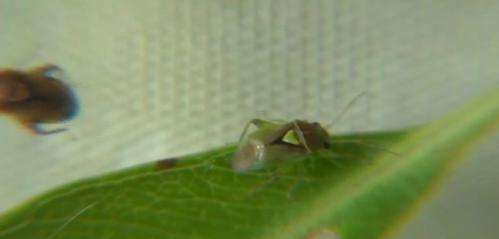August 26, 2013 report
Research duo report first observation of cross species mimicry to ward off reproductive efforts

(Phys.org) —Biology researchers Nikolai Tatarnic and Gerasimos Cassis of the University of New South Wales and Macquarie University in Sydney, report in a paper they've had published in the journal The American Naturalist, the first known incidence of cross species mimicry to ward off the reproductive efforts of the males of another species.
In Tahiti, there are two kinds of crawling bugs (Coridromius tahitiensis and Coridromius taravao) that mate in a rare way, called traumatic insemination—the male stabs the female in the abdomen with a sharp appendage, piercing her side, causing injury and sometimes infections. The male C. tahitiensis are particulary ardent, willing to attempt to mate with other males of its species, as well as both male and female C. taravao. That has led to the females of both species developing markings on their body that resemble the male C. tahitiensis, which are apparently less likely to be targeted by males. The researchers report that this is the first observed instance of the females of one species developing markings on their body to specifically ward off the amorous advances of the males of another species.
The researchers discovered these tendencies in the two species by collecting large groups of both and studying their behavior in the lab. Interestingly, the females of both species do have female genitals on their right sides, which is what the males are apparently supposed to be aiming for. In watching the insects, the researchers found the males rather clumsy, piercing the female abdomen just as often as finding the actual genitalia. The males of both species have a distinctive (and hairy) color pattern on their sides, which coincidently or not, lies near the same area on their abdomen that serves as targets on the females. It was this pattern that the females of both species had evolved to mimic being male, and therefore less likely to be targeted. The researchers also noted that female C. tahitiensis have what appear to be sexual organs on the left side of the abdomens as well but suspect they are not real and only serve as a decoy.
The two kinds of bugs are distinctive species, though they look very much alike. It's not known if cross breeding attempts ever result in offspring, but the researchers intend to go back to Tahiti to find out.
More information: Surviving in Sympatry: Paragenital Divergence and Sexual Mimicry between a Pair of Traumatically Inseminating Plant Bugs, The American Naturalist, www.jstor.org/stable/10.1086/671931
Abstract
Reproductive interactions between species can carry significant costs (e.g., wasted time, energy, and gametes). In traumatically inseminating insects, heterospecific mating costs may be intensified, with indiscriminate mating and damaging genitalia leading to damage or death. When closely related traumatically inseminating species are sympatric, we predict selection should favor the rapid evolution of reproductive isolation. Here we report on a cryptic species of traumatically inseminating plant bug, Coridromius taravao, living sympatrically with its sister species, Coridromius tahitiensis, in French Polynesia. Despite their sister-species relationship, they exhibit striking differences in reproductive morphology, with females of each species stabbed and inseminated through different parts of their abdomens. Furthermore, C. tahitiensis is sexually dimorphic in coloration and vestiture, while both sexes of C. taravao share the C. tahitiensis male expression of these traits. These findings support a role for (1) reproductive character divergence and (2) interspecies sexual mimicry in limiting interspecific mating brought about by indiscriminate male mating behavior.
Journal information: American Naturalist
© 2013 Phys.org

















